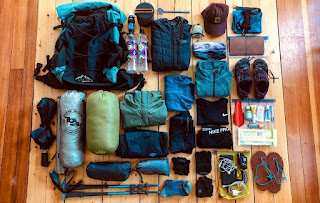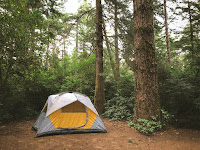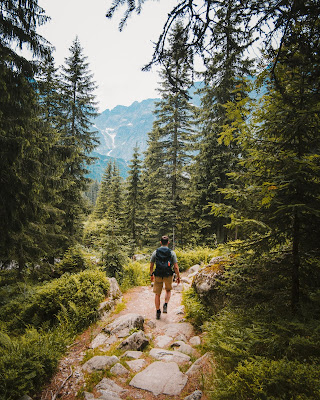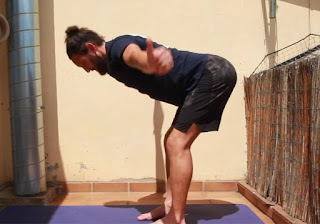TIPS FOR FIRST TIME TREKKERS - "Fit To Trek@50 Series".
The idea with my blog series - "Fit To Trek@50" is to - I want all above 50 to come out of their comfort zone and enjoy themselves more in the mountains, I want them to get out & have a good time in the laps of nature.
The tips that myself will mention in this blog will prevent lot of unfortunate situations when people go for trekking and that they never want to do again.
1. Communication :
this comes down to communicating with the people that you are going out for the trek with. Have a discussion about the rout that you are taking, what is that you require, get some gear list together so that you all are aware who is going to bring what, and their responsibilities are. A healthy relationship among trek mates is very much essential for a successful & fun filled trek.
Also, communicate with your family and few of your close friends about your trek plan and send help if you are not back by certain time, this is probably the most important thing to do when you come out. There are many remote terrains where your mobile phone may not function.
2. Check Your Gear Off A List :
Just before you start for your trek prepare your list of items that you need to carry in your backpack, Also, recheck when putting the items as per your list in your backpack, as it is easy to forget things, this will help you to get rid of the situation where you really need something but you do not find it in your backpack.
Carrying a backpack on a trek is not a big issue, if you know how to keep it light and comfortable. For which, you should know what to pack in it as essentials.
The thing that you should keep in mind is not to pack unnecessary items thinking for " if " situations. "If it rains, all my clothes are going to get we, so I should carry extra clothes ?". Not at all, instead, carry a poncho, to cover yourself and the bag, also use water proof cover for your backpack. So, your clothes and yourself both will be dry.
Here are a list of what exactly to pack on a high altitude trek, to make sure your backpack does not weigh more than 8-9 kilograms. Also, you need to know how to pack these items efficiently in a backpack :
a) For a summer high altitude trek carry 3 warm cloths - your first layer to be a woollen sweater which should be light. Next should be a Fleece jacket, fleece is very light and generally do not weigh more than 50 gms. The next should be a padded jacket, when you are climbing a high altitude, as you go higher it is going to be colder, at nights the temperature is expected to go below 0 degree, this jacket should keep you insulated and warm. This is a very essential item.
If you are going in October / November then add one more layer , and if you are going in December (winter trek) then need to take 5 layers, that is mandatory .
Woollen light sweater.
Padded Jacket
b) The above clothing layers you will be taking along with your T-shirts. Take 3 T-shirts at least, it is advisable to take collard T-shirts as it will cover your neck so that you do not get sun burn along your neck. You can take full sleeve T-shirt as well. You can also wear 2 shirts one on other if additional insulation is required. Do not carry more as you will be over loading yourself.
c) Carry two numbers of trekking pants, which should be of cotton, light and compact. Even if they get wet, will dry up quickly. Try to avoid track pants, unless you do not get trekking pants. If you have no options then take thin track pants which are non-bulky and non-baggy , it should fit you well. Inside you can wear thermals in winter trek, but in summer it is not necessary. This thermal will also keep you warm and cozy at night when the temperature drops. Do not wear thermals while trekking, as it will get sweaty. Only wear them for night.
d) Carry three pairs of under garments , girls carry sports brassieres as they will be comfortable, boys should avoid boxers.
e) Should carry a sun cap with flaps for the day. In the mountains it is going to be very sunny even early in the morning. As this will protect your neck and ears, you will not have to apply sunscreen all over the place. At night you need to wear something to keep your head and ears warm, as most of the heat escapes through your head, for which you need to carry a balaclava or a woollen cap.
Sun cap
Balaclava
f) Carry a neck warmer made of fleece, that you will be using mostly in the evening when it gets windy.
g) Sunglasses - this is must as you will be trekking in the snow whether it is summer or winter, snow blindness is very common if you do not take sunglasses. Also, sunglasses protects your eyes when you are trekking under scorching sun.
h) To keep your hand and feet warm you need gloves and socks. Do not take woollen gloves as you will be handling snow and woollen gloves will get wet. Take synthetic gloves, they are water resistance and will keep you very warm.
For your feet carry cotton sports socks for trekking (do not take ankle length socks), and for night take woollen socks. In case you do not get woollen socks, then wear 2 layers of cotton socks at night, that will be fine.
i) A very important item is a Poncho. It is basically like a rain coat but it covers from your head to toe including your backpack. In the mountains it is mandatory to carry as you never know when it will rain.
j) You also need a head lamp. You can use it when going to loo at night or when trekking late evening or very early in the morning before sunrise .
k) Another mandatory item is Trekking Pole . During a mountain / high altitude trek you will be going up and down which will be very tiring, trekking poles will save nearly 40% of your energy. Make sure to carry these.
l) Toilet & Medical Kits . Your toilet kit should consist of a tooth brush, a tooth paste, a moisturizer ( preferably a petroleum jelly), face wash/soap, chap-stick for your lips. Should carry one sun screen above SPF 40 & use it every three hours during the trek. Also, toilet paper, in the mountains usually have dry toilets, there wont be much water, so you will be needing this. Most important, should carry hand sanitiser.
Medical kit should have items that you may need in case of any emergency during your trek, along with your prescribed medicines that you regularly take.
It is always advisable to consult your doctor for any medicine that you carry, and also consult your doctor about how to have them in case of emergency.
A suggestive medical kit items are mentioned below :
1. Diamox - 10 tablets (Acute Mountain Sickness - AMS).
2. Calpol/Crocin - 6 tablets. (Fever / body ache).
3. Avomine - 4 tablets (motion sickness).
4. Avil 25mg - 4 tablets (allergies).
5. Combiflam - 4 tablets (pain killer).
6. Disprin- 10 tablets (headache).
7. Norflox TZ & Lomofen - 6 tablets (diarrhea).
8. Digene - 10 tablets (acidity).
9. Omez / Rantadine - 10 tablets (antacid).
10. Crepe bandage - 3 to 5 meters.
11. Gauze - 1 small roll.
12. Band aid- 10 strips.
13. Cotton- 1 small roll.
14. ORS - 10 packets.
15. Betadine or any antiseptic cream (Cuts & bruises)
16. Moov spray - (aches & sprains).
17. Mosquito / Insect repellent cream (mainly if camping in jungle area).
m) Carry your own cutlery , take your own drinking mug (for drinking water and tea/coffee), lunch box and a spoon, because you need to wash and clean your own cutlery, and there might be water scarcity at high altitude.
n) Two numbers of 1 LITRE plastic bottles, avoid mineral water bottles as you should not discard or leave anything behind. Take bottles that you do not have to discard.
o) Take a pair of slippers (floaters / flip-flops) for use at camp sites.
p) Spare plastic bags , for keeping used under garments or used socks, wet cloths, garbage like biscuit wrappers etc. Also carry spare plastic zip-lock bags so that women can keep their used sanitary pads and bring them down.
Zip-lock plastic bags.
q) Carry a light face towel, to wipe your face and hands after a wash, as you will not be able to take bath at such treks. You may also carry body wipes.
r) Carry small snacks, like few small packs of biscuits ( Sunfeast Farmlite Biscuits, Parle -G, FittR - Multi Millet Cookies, Sunfest Farmlite Digestive, etc) nuts, dry fruits (to keep your energy levels up), energy bars etc. Energy bars may be taken while trekking, but not a necessity. Because, your body will require a lot of energy and they can be handy to replenish your depleted energy. Some of the brands available in the market are - "Fast & Up Energy Gel" , "Yoga Bar", "Nouriza Bar - Nuts & Seeds" , "High Protein Bar", "Proathlix Protein Bar", "Hearty Bite Superfood Energy Bars", and many more. You can also order these on-line.
s) Carry a day pack (small backpack) which you can fold and keep in your backpack, in which you can carry your two water bottles, first-aid kit, jacket etc., in case you decide to off-load your backpack and go for the summit climb or a short off rout trek, where you go and come back to the main camp site.
t) Your sleeping mat, your sleeping bag and if trekking solo then your portable waterproof camping tent.
Sleeping Mat
Sleeping Bag
Tent
u) All these items you have to pack in a 55-60 litre backpack. The idea is to carry as less thing as possible. Do not over load your backpack as you will be only carrying your own load.
55 Litres Backpack
How To Pack Your Backpack
v) Trekking Shoes. Trekking shoes play an important role during a trek. A comfortable and good pair of trekking shoes can give you a feel like an extension of your feet. On the other hand an ill-fitting pair with faulty design can slow down or even halt your trek causing injury / blisters on your feet. Your shoes should be all weather.
While selecting your trekking shoes you need to keep the following aspects in mind :
1. Check for good grip in the trekking shoe.
2. Softness and flexibility of shoe sole.
3. There should be ankle support in the trekking shoe.
4. Go for Snug-fit shoe, meaning your shoe should be one size larger than your normal size, as without that extra space, you would develop shoe bites due to the rubbing of the toe against the shoe wall, also it gives extra room for your socks / woollen socks , especially during winter treks. This extra space gives your feet enough space to breathe during long treks.
5. Water resistance is very much needed.
Few of the good quality brands in trekking shoes are - Quechua trekking shoes or shoes from Woodland.
3. Start Cold :
this is especially true when you are going for a high altitude trek. When you start trekking, after 15 to 20 minutes you are going to be warm with all these layers on. What I recommend is, feel like you are cold when you start trekking, strip off few of the layers of cloths, do some spot jumps/jogs, jumping jack or burpees , or what ever you need to do to bring your heart rate up before your start your trek. Start with one or two layers of clothing less than you normally would and that would mean you do not have to stop after first 15 - 20 minutes and will help you to get into a good rythm , this will help you to cover first hour without having to stop and change.
4. Drinking Water Safely :
where you get it from during the trek. There are many different ways of filtering and purifying water it all depends where you are trekking, but the simplest version is getting water purifying (chlorine water treatment) tablets or drops, that is the simplest and cheapest way to do it. Bad experience with bad water brings your trip down.
Also, very important is the source of water, couple of things you need to look out for while looking for the source of water are - try to collect water from the earth if possible, that is if there are some sort of fountain or tiny stream that is coming directly from the ground where it is getting filtered naturally through earth and through rocks, then it is probably going to be really good water. The other source you may find is a up-steam, here you need to see that is it coming from a height where there may likely be a dead animal which may poison the water. In such case you need to go higher to get cleaner water.
Drinking water quality can make a successful trek or a nightmare.
Drink at least 6 litres of water through out the day, when trekking. This will prevent muscle cramps and keep you hydrated. Also, water contains oxygen, which can compensate for the low oxygen levels on high altitude treks.
5. Navigation Skill :
Knowing what the challenges are along the way, understanding the rout, having a map and compass, and knowing how to use them. Of course now there are so many gadgets like GPS watches, mobile apps, but they all require batteries which has to be taken care by keeping them warm when the temperature drastically drops at high altitude - "COLD KILLS BATTERIES". So, your maps and compass acts as your back-up plan when you get off rout or get lost , this may get very serious when trekking on few of the remote terrains un-guided. You just need to know the basics of how to use a map and compass.
6. Physical Preparation :
This is most important aspect when preparing for a trek , especially a mountain trek. This myself has dealt in details on my below mention previous blogs :
a) 9 Basics for Mountain Trek Training.
b) First Time Trekkers : common health related questions.
c) How To Prepare For Mountain Treks (Beginners).
d) How to Build Lower Body Strength For Trekking.
e) Upper Body Strength Training Exercises For Trekkers.
f) Best Cardio Exercises For Mountain Trekkers.
g) How To Improve Your Lung Capacity For High Altitude Treks.
h) Trekkers Strength Workout For Endurance.
Also, you will find videos with workout demonstration on above topics on my YOUTUBE channel : " fitnessfun50 ".
7) Avoid early morning caffeine cravings, as they lead to dehydration. Steer clear of alcohol before and during the trek. Alcohol leads to dehydration that could trigger Acute Mountain Sickness (AMS) during a high altitude trek.
8) Avoid Chocolates, sugar candies and cream biscuits. This definitely give you a sudden boost of energy, but because they almost entirely rely on sugar and corn syrup it results in an unhealthy peak and drop energy cycle. This will give rise to hunger pangs after a while.
9) Avoid eating non-vegetarian food. Proteins take a longer time to digest at high altitude due to low oxygen levels. You can consume egg instead. This will prevent sore muscles and helps replace broken-down muscle protein.
10) Eat a healthy wholesome breakfast. It will set you up for the day. Your lunch and dinner must consist of carbohydrate - rich food and whole grains. They digest slowly, giving you more stable energy during the day.
TIPS FOR FIRST TIME TREKKERS - "Fit To Trek@50 Series".
Most of the trekking items mentioned above are available online (Amazon) , and at various trekking gear stores (Decathlon store).
Your valued comments, questions & suggestions in the comment section below, about this blog will be highly appreciated.
Do FOLLOW my BLOG PAGE for latest updates on FITNESS.
- My Facebook Page : @fitnessfun50
- My YouTube channel : fitnessfun50
- Follow me on TWITTER : @ParthaD44328477
- Instagram : fitnessfun.50
- e-mail : partha63.pd@gmail.com

















































